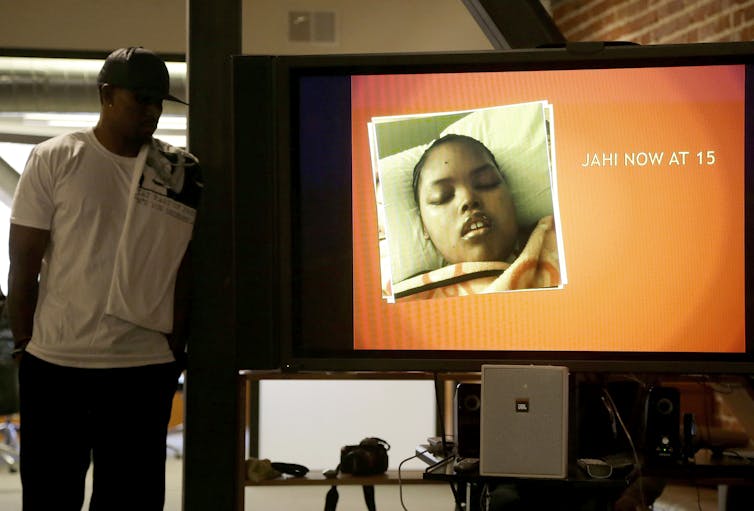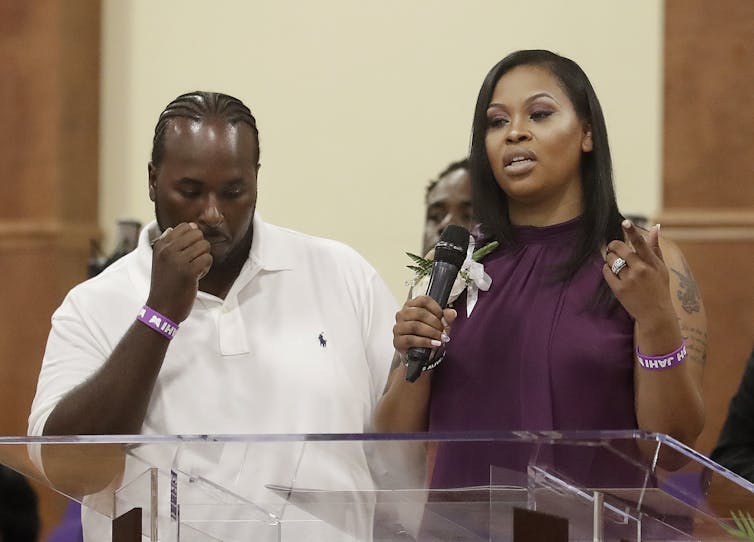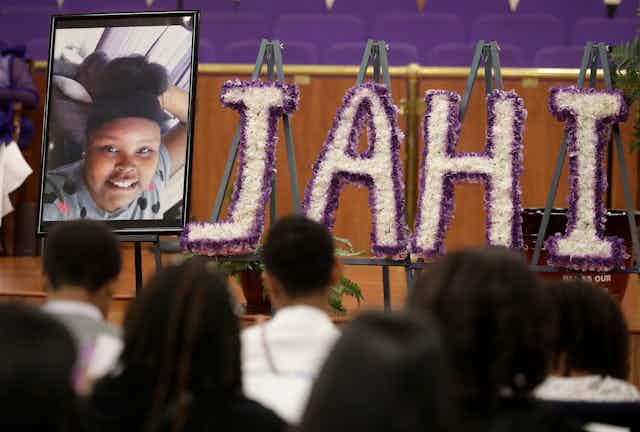California teenager Jahi McMath, who suffered catastrophic brain injury as a result of a routine tonsil surgery, died on June 22, 2018.
Her death came after four years of her family fighting in court to continue her care in California. Eventually, they moved her to a facility in New Jersey, a state that accommodates religious views that don’t recognize brain death.
Much of the popular discussion in the case centered on the family’s refusal to accept the diagnosis of brain death. However, as a philosopher who writes on bioethics and race, I believe an underappreciated aspect of the discussion was the role of race – both in how the medical personnel dealt with the family and how the family interpreted their interactions with the medical establishment.
The surgery and outcome
On Dec. 9, 2013, the 13-year-old McMath entered Children’s Hospital and Research Center in Oakland, California, for what should have been a routine tonsillectomy. The young girl was, according to her mother’s account, frightened that something would go wrong. Her mother reassured McMath that she would be okay.
McMath’s post-surgical complications began about an hour after her surgery. A nurse provided a bin to catch the blood that McMath had begun spitting up. Although the nurses indicated to the family that some post-surgical bleeding was normal, two hours later, McMath’s blood filled two plastic bins and the bandages packing her nose were saturated with blood. Her hospital gown was also covered in blood.
According to the family, four and a half hours passed before a physician saw her, despite the family’s repeated pleas for intervention. The hospital has maintained that they can not discuss Jahi’s case in detail because of privacy laws. Bleeding complications, though rare, can occur after tonsillectomy because tonsils are near arteries.
As a result of the immense blood loss, McMath’s heart stopped and her brain was deprived of oxygen. Three days later, on Dec. 12, 2013, the medical staff at Children’s Hospital declared McMath brain dead. Hospital personnel encouraged the family to withdraw life support and donate her organs.
McMath’s family refused to accept the diagnosis, and a court battle to keep McMath on life support ensued.
A judge in California initially ruled that McMath could remain on life support until Jan. 7, 2014. However, the Alameda County coroner issued a death certificate anyway.

Philosopher Jeffrey P. Bishop, who holds the chair of health care ethics at Saint Louis University, writing in Harvard Divinity School bulletin noted the ethical oddities of the case. In California, once two physicians confirm brain death, the patient is legally dead. The body is then technically released to the coroner before being released to the family so that they can make arrangements. In the case of McMath, she was still in the hospital and on a ventilator when these procedures kicked in.
From the beginning, the case was tangled up with all sorts of questions regarding the nature and diagnosis of brain death. Although there are long-established criteria, how brain death is determined in practice can vary. These differences in practices can contribute to confusion, particularly among the lay public, about brain death.
Her family rejected the brain death diagnosis alleging the hospital had a conflict of interest and simply wanted McMath’s organs.
Revisiting a history of medical racism
Rather than dismiss the family’s concerns as paranoid or ignorant, it is important to understand the historical realities faced by black patients in their encounters with the U.S. medical system.
There is a long historical record of using African-Americans for medical experimentation. For example, medical experimentation performed by J. Marion Sims, “the father of modern gynecology,” highlights the medical establishment’s disregard for black people.
Sims, who began conducting his gynecological experiments in the 1840s, is credited with developing a surgical procedure to repair vesicovaginal fistula, a hole that develops between the vaginal wall and the bladder, resulting in incontinence. However, Sims achieved his success by experimenting on enslaved women, often without anesthesia.
Sims wasn’t the only one. During the 19th century, medical schools used both enslaved and free black people, often without their consent, to teach their white medical students anatomy, disease progression and diagnosis. This practice continued after slavery.
Additionally, the graves of African-Americans were robbed and their bodies disinterred so that medical students could use black bodies as cadavers. Aware of these practices, African-American communities were deeply suspicious of local medical schools and unsure whether the medical personnel were actually “treating” them or merely “experimenting” on them.
Few examples of the abuse of African-Americans in medical experimentation loom larger than the Tuskegee syphilis experiment – a 40-year-long study of disease progression of syphilis in 600 men in the Tuskegee, Alabama, area that began in 1932. The study was sponsored by the U.S. Public Health Service.
None of the 399 men who had syphilis were ever told of their diagnosis. Nor were these men or their partners treated with penicillin once penicillin became the standard treatment for syphilis in 1945. In 1997, President Bill Clinton issued a formal apology on behalf of the U.S. government to the eight remaining survivors of the Tuskegee experiment.

One presidential apology, however, could not erase the sense of mistrust that many African-Americans feel toward health care institutions.
And the medical injustice continues: There are wide gaps in outcomes between whites and African-Americans in a variety of diseases. For example, the American Cancer Society reports that, of all the racial and ethnic groups in the U.S., African-Americans, are more likely to die from most cancers.
Lower quality of care?
African-Americans also report lower quality of health care and greater dissatisfaction with the care they receive. In addtion, they are significantly more likely to report experiencing racial discrimination and negative attitudes by health care personnel than non-Hispanic whites.
Medical mistrust and the resulting dissatisfaction have been connected to patient anxiety, as well as lower engagement in health care decision-making between patient and provider.
This mistrust makes African-Americans less likely to use the health care system. Along with other factors, such as limited insurance status and greater geographic distance from health care providers, it contributes to disparate health outcomes.
It is against this backdrop that one must understand the McMath family’s skepticism regarding both her treatment and diagnosis.
McMath’s mother, Nailah Winkfield, told The New Yorker,
“No one was listening to us, and I can’t prove it, but I really feel in my heart: if Jahi was a little white girl, I feel we would have gotten a little more help and attention.”

Sadly, Winkfield is not alone in her suspicions.
It is possible that the ultimate outcome might still have been tragic. Even with the most attentive care, McMath might have died. However, the family feeling that the medical team did not do all that they could have done for their loved one, and that this, for them, was a function of race, needlessly inflicted additional injury.

